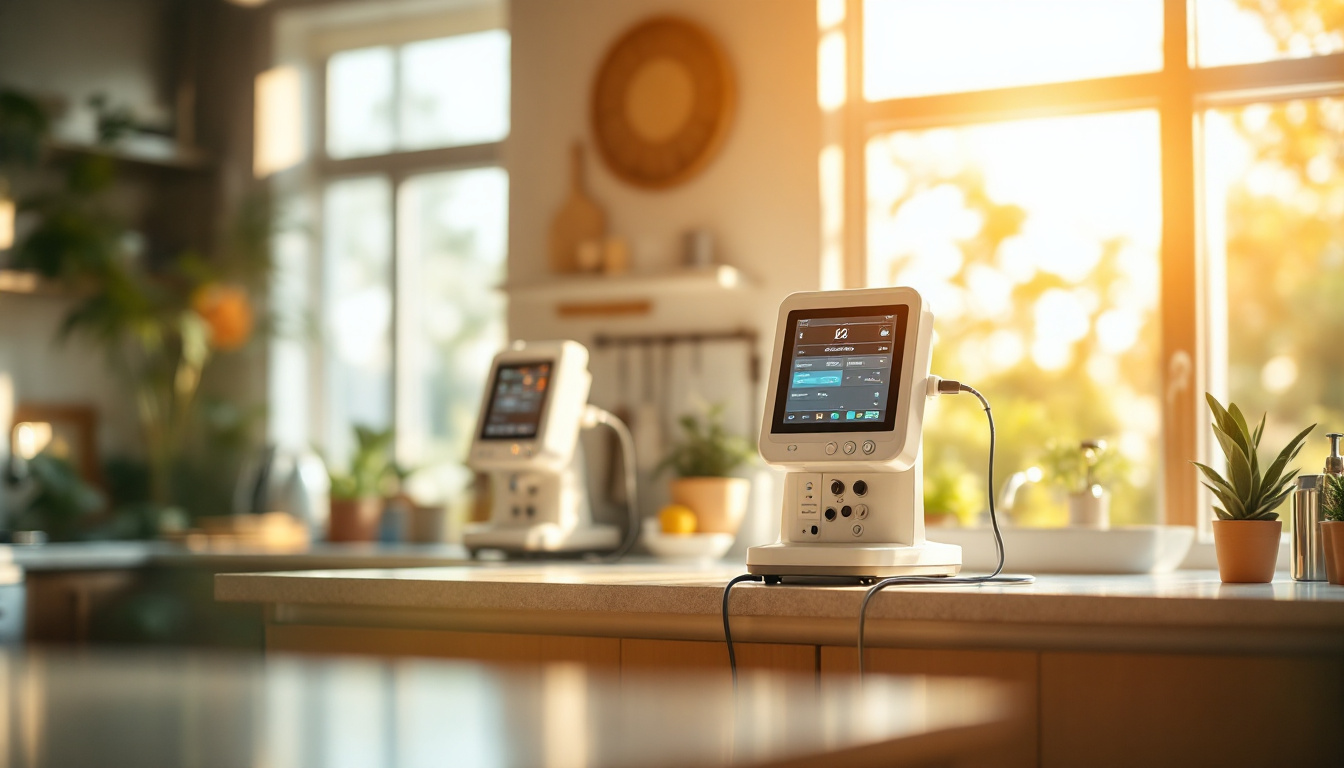How to Train Patients and Caregivers for Home TPN Therapy

Introduction to Home TPN
Total Parenteral Nutrition (TPN) is a lifeline for patients unable to nourish themselves through traditional means. Administered intravenously, TPN provides essential nutrients directly into the bloodstream, crucial for those with severe gastrointestinal disorders or malnourishment. With advancements in medical care, more patients are now receiving TPN therapy at home. This shift empowers patients with greater independence and improved quality of life while alleviating prolonged hospital stays. However, transitioning to home TPN requires thorough training and a comprehensive understanding of protocols to ensure patient safety and successful outcomes.
Understanding Total Parenteral Nutrition (TPN)

What is Total Parenteral Nutrition (TPN)?
Total Parenteral Nutrition (TPN) is a method of feeding that bypasses the gastrointestinal tract through intravenous administration of nutrients. This treatment is specifically designed for patients who are malnourished or have non-functioning gastrointestinal tracts, making TPN their sole source of nutrition.
TPN solutions typically include carbohydrates, lipids, proteins, vitamins, minerals, and water, collectively aiming to meet the nutritional needs of patients.
Courses on TPN are crucial for healthcare professionals, covering essential topics such as:
- Overview of TPN practices
- Access and administration techniques
- Feed preparations and additives
- Monitoring for potential complications
The education on TPN is CPD accredited, allowing healthcare professionals to earn Continuing Professional Development hours, reinforcing the importance of standardized education in clinical settings.
Who needs TPN?
Patients with gastrointestinal dysfunction, including conditions like Crohn's disease, short bowel syndrome, or severe malnutrition, often require TPN. Approximately 40,000 U.S. patients are currently using this therapy at home, gaining greater independence and enhancing their quality of life.
TPN administration basics
TPN is typically administered through a central venous catheter (CVC) placed in a large vein, allowing for long-term nutritional support. The infusion usually takes around 10 to 12 hours, mainly during the night, which facilitates normal daytime activities.
Before utilizing TPN, it’s critical to prepare properly: patients must allow TPN bags to reach room temperature by taking them out of the refrigerator at least two hours prior to use. Furthermore, adhering to strict hygiene practices during preparation and administration is vital to minimize the risk of infection.
Home Transition: TPN Setup and Training Essentials

Can TPN be given at home?
Yes, TPN (Total Parenteral Nutrition) can be administered at home. This process involves delivering a mixture of nutrients directly into the bloodstream via a central venous catheter. Typically, the infusion lasts from 10 to 12 hours overnight. This transition allows patients to enjoy greater independence and quality of life.
How is the home infusion setup performed?
Setting up TPN at home involves several critical steps:
- Preparation Area: Designate a clean space free from pets and contaminants for TPN preparation.
- Storage: TPN solutions must be stored in the refrigerator and allowed to reach room temperature before use—this takes about 2 to 3 hours.
- Supplies: Gather sterile barriers, syringes, alcohol wipes, and a sharps container prior to preparation.
What are the training protocols for TPN administration?
Patients and caregivers must undergo training led by TPN-trained nurses. This training includes:
- Hygiene Practices: Regular handwashing and maintaining a sterile environment.
- Complications Monitoring: Identifying potential issues with the infusion site and central line.
- Medication Handling: Correct procedures for adding medications to TPN and ensuring proper mixing.
What is the role of skilled nurses in home care?
Skilled nurses are pivotal in supporting home TPN patients. They assist with:
- Initial Setup: Help with TPN setup during the first few nights at home.
- Ongoing Monitoring: Change the central line dressing, perform assessments, and provide guidance on tracking vital signs.
- Education: Ensure patients and caregivers understand all aspects of managing TPN safely at home, emphasizing the importance of open communication for troubleshooting and support.
This comprehensive approach empowers patients to manage their nutrition effectively while minimizing health risks.
Step-by-Step Guide: Administering TPN at Home

What are the key steps to administering TPN at home?
The process of administering Total Parenteral Nutrition (TPN) at home requires thoughtful preparation and execution. Here are the steps to follow:
Prepare the Environment
- Choose a clean, well-lit area free from contamination, ideally away from bathrooms and pets.
- Ensure all necessary supplies are ready: sterile barriers, syringes, alcohol wipes, sharps container, and the TPN solution itself.
Temperature Adjustment
- Take the TPN bag out of the refrigerator at least 2 hours before use to allow it to warm to room temperature. This improves patient comfort.
Inspect the TPN Bag
- Before use, examine the bag for any cloudiness, color changes, or leaks. Do not use if any abnormalities are detected.
Administration Preparation
- Follow clinician instructions carefully when adding any necessary medications. Clean medication ports with alcohol wipes prior to administration.
- Prime the IV tubing using the TPN solution to prevent air pockets.
Infusion Process
- Connect the tubing to the central venous catheter (CVC) and begin the infusion. This typically takes 10 to 12 hours, often during the night.
Monitoring During Therapy
- Track health parameters regularly, such as weight, blood sugar levels, and temperature. Maintain close communication with healthcare providers for personalized guidance and support.
By adhering to these steps, patients can ensure safe and effective administration of TPN at home, supporting their nutritional needs.
Education and Training for Safe TPN Management at Home

What should patients and caregivers learn to manage TPN safely at home?
Patients and caregivers must acquire essential skills to manage TPN safely. They should understand their nutritional needs, as well as the steps required for preparing and administering TPN. Key aspects include:
- IV Care Instructions: Maintaining cleanliness around the IV site is essential to prevent infection.
- Hand Hygiene: Regular handwashing is vital, especially before handling TPN supplies.
- Checking Supplies: Always inspect TPN bags for expiration, leaks, and cloudiness before use.
- Proper Storage: Store solutions in a refrigerator and allow them to reach room temperature prior to infusion.
- Disposal Protocols: Careful disposal of IV-related materials prevents contamination.
- Recognizing Complications: Being vigilant about signs of infection or blockage is critical.
Reliable resources like MyHealth.Alberta.ca can guide patients in managing TPN at home effectively.
Resources and classes for TPN education
Education on TPN management is structured into comprehensive training programs. Patients and caregivers can access:
- Family Learning Centers: These centers offer classes on home PN therapy, emphasizing hands-on practice.
- Online Resources: Organizations like ASPEN and the Oley Foundation provide vital information and support.
- Coram Care Team: Their resources include educational materials specifically designed for TPN preparation and administration.
Training sessions often include monitoring logs to help track health indicators, ensuring that both patients and caregivers feel confident in managing TPN safely at home.
Overcoming Challenges of Home TPN

What are the potential challenges of administering TPN at home, and how can they be addressed?
Administering Total Parenteral Nutrition (TPN) at home can present several challenges that patients and caregivers must navigate. One major concern is the heightened risk of infection due to less sterile environments compared to hospitals. Patients need to maintain strict hygiene practices, such as thorough handwashing and cleaning the preparation area, to minimize this risk.
Additionally, there may be difficulties with the technical aspects of infusion, including setting up the equipment and monitoring the infusion process. Thus, comprehensive education and hands-on training from healthcare professionals are essential. Patients and caregivers should have clear guidelines on preparing and administering the TPN solution, including steps for mixing additives like insulin or vitamins.
Financial challenges can also impact adherence to therapy. Home TPN is typically more cost-effective than prolonged hospital stays, but patients must still manage supply expenses. Establishing reliable supply chains and creating financial plans can alleviate some of this burden.
Finally, patients may face psychosocial challenges, including the adjustment to managing their nutrition independently, which can be overwhelming. Providing emotional support through caregiver education and regular communication with healthcare providers fosters confidence and enhances patient engagement in their care. By focusing on these areas, patients can successfully overcome the hurdles associated with home TPN therapy.
Continuous Support and Follow-Up Care in Home TPN
Role of healthcare professionals
Healthcare professionals, including nurses, pharmacists, and dietitians, play an integral role in the management of home Total Parenteral Nutrition (TPN). Their responsibilities encompass developing personalized TPN regimens tailored to each patient's unique nutritional requirements. Additionally, they provide ongoing support and education to both patients and caregivers, ensuring all parties are well-prepared for home therapy administration.
Monitoring and follow-up care
Effective monitoring is essential for patients on TPN. Routine follow-ups, where healthcare providers assess key indicators such as blood glucose, electrolytes, and overall nutritional status, help in adjusting the TPN mixture if necessary. Nurses will often instruct patients to maintain logs to track their weight, intake/output, and any signs of complications. This regular oversight is vital for preventing serious issues related to the central venous catheter and maintaining nutritional equilibrium.
Community resources for support
Patients and caregivers can also benefit from community resources available for TPN management. Organizations such as the Oley Foundation and Feeding Tube Awareness Foundation offer essential information, support networks, and additional education on home nutrition therapies. This community engagement complements the clinical support received from healthcare professionals, fostering a robust support system for those adjusting to home TPN therapy.
What training is essential for nurses handling TPN?
Nurses handling Total Parenteral Nutrition (TPN) require comprehensive training focused on several critical areas. They must be proficient in monitoring nutritional status, managing fluid balance, and recognizing potential complications such as infection and electrolyte imbalances. Knowledge of TPN composition and how to adjust it based on individual patient needs is essential. Regular monitoring of blood glucose levels, laboratory results, and daily weight assessments is also crucial to ensure optimal patient outcomes. Additionally, understanding the nursing care planning process and employing effective patient education strategies contribute to improving the overall care process for those receiving TPN.
Embracing Home TPN for Improved Well-being
Transitioning TPN therapy from hospital to home can significantly enhance the quality of life for patients while minimizing healthcare costs. However, to achieve successful outcomes, it is crucial that patients and their caregivers receive thorough training and access to ongoing support. By empowering them with the necessary skills and knowledge, home TPN can not only sustain the nutritional needs but also enable patients to regain a sense of normalcy and independence in their daily lives. With the right education and community resources, the challenges associated with home TPN can be effectively managed, ensuring a safe and fulfilling journey for patients and caregivers alike.
References
- Home Total Parenteral Nutrition (TPN)
- Living With TPN at Home - AmeriPharma® Specialty Care
- Education methods and techniques for training home parenteral ...
- Patient Instructions: Home Parenteral Nutrition Therapy
- Preparing a patient for home parenteral nutrition (HPN)
- Patient and Caregiver Education - ASPEN
- [PDF] Total Parenteral Nutrition: Home Care Guide - Northwestern Medicine
- [PDF] Your guide Home total parenteral nutrition therapy - Coram
- Engaging Patients and Caregivers in a Transdisciplinary Effort to ...
- Thriving with TPN at Home: The Benefits of Home Health Care ...



































































































